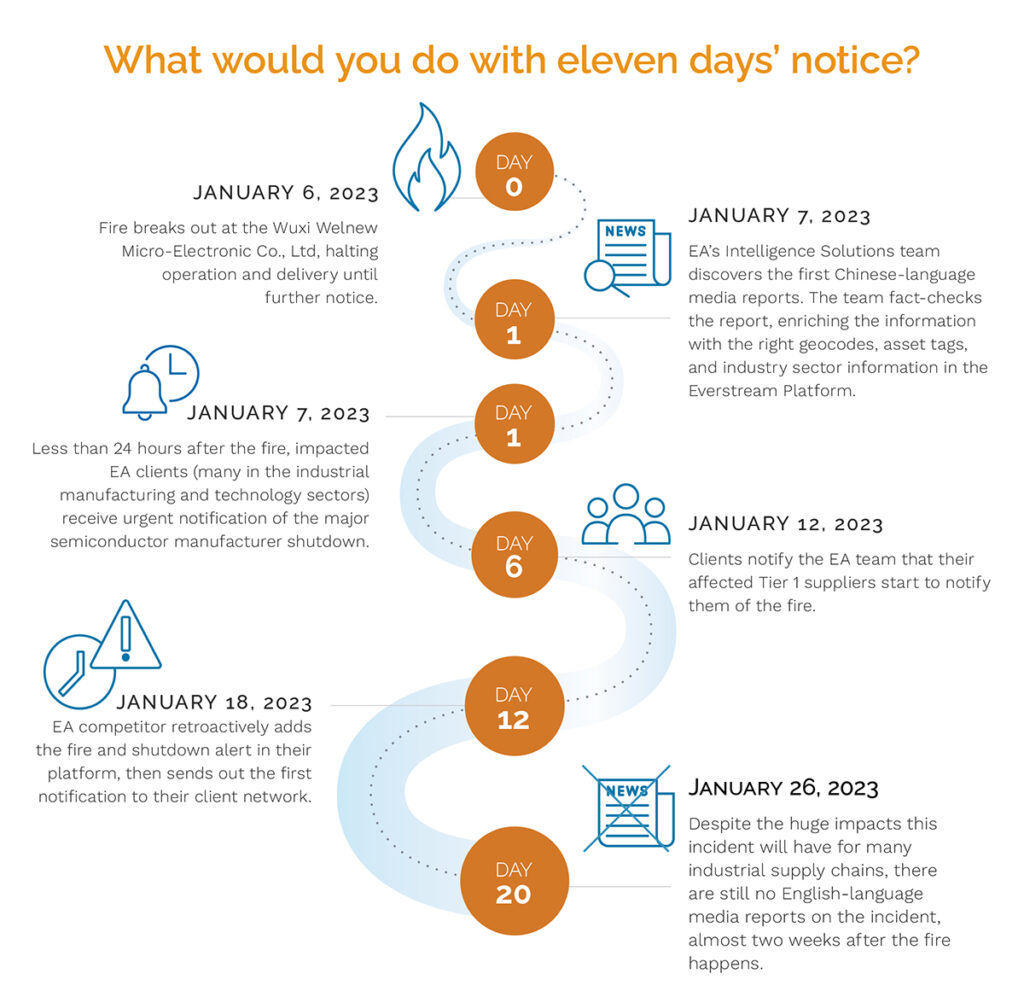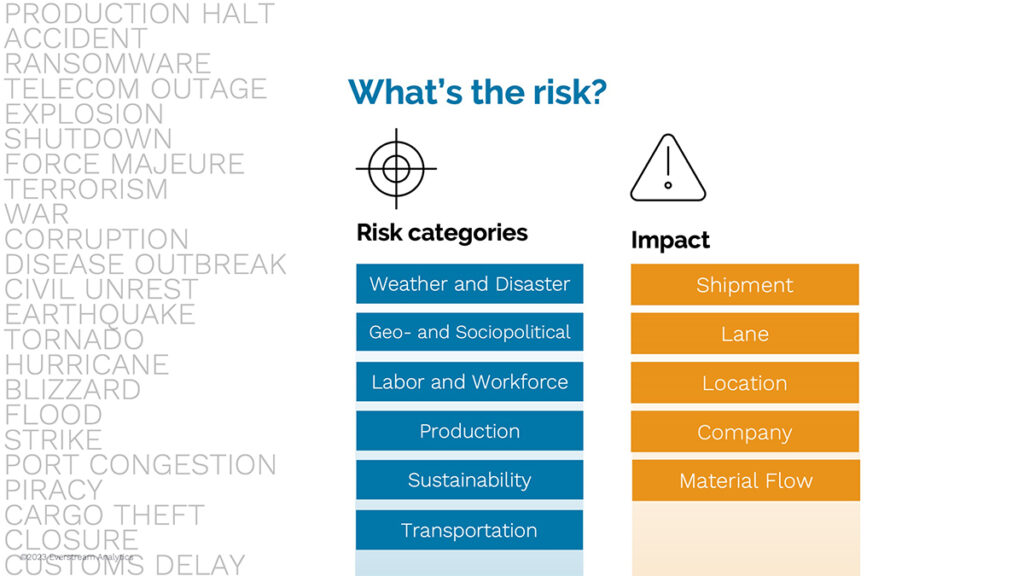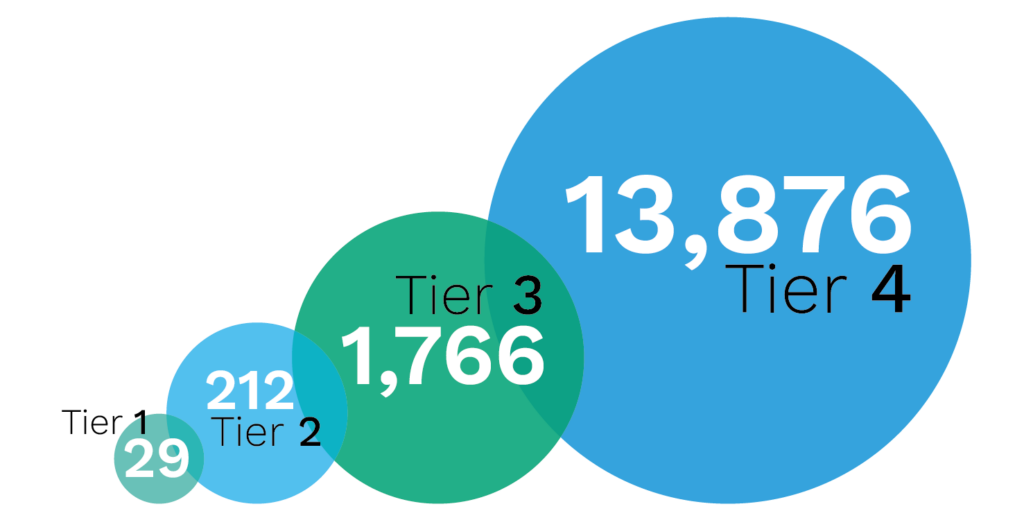What’s at risk if your operation doesn’t have supplier visibility? “Visibility” is more than the latest supply chain buzzword. It’s rapidly becoming the differentiator between companies with smooth supply chain operations versus those still facing pandemic-era disruptions and delays.
Supply chain managers work closely with their suppliers to anticipate and plan around delays and disruptions. But what happens when one of their suppliers, hidden deep in the sub tiers, has an incident? A distant fire, strike, or extreme weather event can hit your business months later with costly delays, fines, and unhappy customers.
This type of “hidden” disruption is why supplier visibility is making headlines in the supply chain world. But it’s more than just a trend. Easier compliance, competitive advantage, and cost savings are some of the reasons why leading companies are focusing on supplier visibility.
What is supplier visibility?
Supplier visibility sounds like a simple concept. It means monitoring the suppliers within all tiers of your value chain and understanding the potential risks throughout the network. Monitoring and catching risk early is key to creating resilient supply chain operations.
Before artificial intelligence, this detailed overview was difficult to execute, especially as supply chains grew increasingly complex, global, and interconnected. Supply chain visibility software has removed several traditional stumbling blocks.
The first problem: Your Tier 1 suppliers probably still don’t have visibility to their sub tier. Even if they respond to surveys (which many don’t), they likely won’t have the depth of insight you need.
In addition, when it comes to mapping sub tier suppliers across the world, it often turns out that a company’s headquarters and various operational facilities aren’t at the same address. Somehow supplier visibility must accurately identify and map the locations that are relevant to your operation.
Once those suppliers are identified and mapped, supplier visibility shifts to include ongoing monitoring for relevant risk rather than every risk. For example, if your operation works with a supplier in Bangladesh, you don’t need alerts for every single power outage in the country – only for the area where your supplier (or theirs) are based.
And finally, all types of supply chain risks should be scored according to how likely they are to impact your operation. For example, a hurricane bearing down on the Texas coast might not affect a supplier that can fill your order to another facility, but if shifting to that facility includes higher freight rates then that risk might merit a higher score.
To summarize, supplier visibility must include:
- All suppliers in a company’s value chain, down to the raw materials level
- Relevant supplier locations, including individual facility addresses
- Ongoing monitoring and scoring for the risks that matter to your operation
Why is supplier visibility important?
Achieving full supplier visibility arms organizations with resources to evaluate risks across the entirety of the supply chain, and to take preventative action sooner. If an event has already occurred, the organization can also take advantage of the increased options that full visibility offers.
A responsive supply chain minimizes costs, downtime, and delays.
Without a full and ongoing understanding of your organization’s supply chain risk, it’s easy to be caught unaware by emerging situations that turn into full-blown disruptions. Operational disruption not only creates delays and customer dissatisfaction, but also hefty costs as your organization attempts to solve the interruption after the problem has already emerged.
In fact, you’ll usually be racing your competitors to implement the same risk workarounds. In those cases, supplier visibility can give you valuable competitive advantages. The first organization that notices a potential disruption has the most lead time to take mitigation action, such as buying up stock (before price increases), switching to a secondary supplier, or routing shipments to alternative ports.
For example, a factory fire recently shut down a major semiconductor manufacturer in China. The manufacturer’s suppliers only started reporting the disruption to their customers six days after the fact. The fire wasn’t mentioned in an English-language news outlet until nearly two weeks later. Downstream operations without supply chain visibility were blindsided by a full halt to their operations, and had to scramble to find another semiconductor supplier, reschedule production and shipping, and more changed plans. However, the organizations with full supply chain visibility were able to make quick, effective decisions, and had the first choice of alternate suppliers and scheduling options.
Don’t let your competitors get a first-mover advantage.

Figure 1: Companies with supplier visibility gained 11 days of planning time over the competition
Supplier visibility for compliance
Governments and regulators increasingly expect, and even demand, that businesses take responsibility for the conditions within their supply chains. In fact, the proposed EU Supply Chain Law spells out the requirement for companies to have full visibility across their value chain, down to the sub tiers.
Ignorance is no longer an acceptable excuse, and organizations are liable for significant fines and product seizures if they are found to have forced labor, bad environmental practices, and other issues within their supply chain.
As sustainability and human rights compliance standards become more rigorous, organizations can easily find themselves on the wrong side of a regulation. Supplier visibility is key to monitoring regulations, then spotting and preventing or halting supply chain legislation violations. With full visibility, organizations can also document and share their compliance efforts with stakeholders.
So, having the ability to fully evaluate, rate, and mitigate ongoing risk is a must-have for any modern business. This includes your Tier 2 suppliers, their suppliers, and their suppliers’ suppliers.
Implementing supplier visibility
You’re ready to implement supplier visibility into your supply chain management strategy – now what?
Time for a visibility check
Up until now, ensuring comprehensive supplier visibility has been difficult, with most organizations using manual, survey-based systems that only gathered information from Tier 1 suppliers. Information was collated sporadically, as suppliers rarely provided accurate details in a timely manner. Organizations had little recourse to verify this information or to collect data independently, including weather forecasts, geopolitical issues, and other risk data.
Additionally, sub tiers were almost impossible to track. Organizations had to trust that their Tier 1 suppliers were providing complete, accurate, and timely information.
Once that data was collected, supply chain management teams had to analyze the data to try to make the best supply chain decisions. Given how quickly circumstances can change within a supply chain, this led to slow, manual, and ultimately ill-informed decision-making.
20/20 visibility
Now, with the advent of artificial intelligence and supply network mapping, implementing continuous supplier visibility is much more manageable. Supply chain visibility tools help your organization visualize risk across a supply network by aggregating relevant risk data from a variety of sources and providing detailed risk analysis. Since the data is pulled from multiple sources, it also includes risk data that suppliers may not provide, such as weather and climate risks, ongoing geopolitical situations, and more.
Using that risk analysis, today’s supply chain risk management systems can even make automatic risk prevention decisions for common disruptions and delays, allowing risk management teams to focus on more complex emerging issues.
And, instead of waiting for incidents to occur, prompting rushed and panicked risk management decisions, the risk management system highlights potential upcoming risks, giving the supply chain management team the information to make proactive mitigation decisions.

Figure 2: Supplier visibility must include risk ratings by type of risk that is most impactful on business operations.
Case study: Medtronic’s supplier visibility in action
Medtronic, a global medical device company with patient-critical products, needed to map their entire supply chain to prevent time-consuming disruptions that could affect patient safety. The sooner the organization is aware of potential risk, the sooner they can pivot to other solutions to minimize delays.
Using Everstream’s supplier visibility and risk management platform, Medtronic was able to visualize their entire supply chain network. For one product alone, they discovered that their sub tier network expanded exponentially from 29 Tier 1 suppliers to over 13,000 Tier 4 suppliers, none of which they had visibility to previously.

Figure 3: Medtronic’s supplier visibility exercise revealed an exponential explosion of sub tier suppliers.
Before mapping the network, notification of an incident at the Tier 4 level took approximately four months, leaving Medtronic in a reactive position against disruptions within their sub tiers.
With Everstream’s mapping, continuous gathering of data, and AI-powered analysis, this supply chain management team is now almost instantly aware of any risks that pop up across their supply chain. They have shifted from reactive to proactive planning, making educated decisions to maintain operations for their patient-critical products.
Supplier visibility isn’t just a new supply chain buzzword – it’s the backbone of modern supply chain management. Visibility supports compliance, competitive advantages, and cost savings for the companies that adopt it.
Without full supply chain visibility, including your organization’s sub-tier suppliers, it’s almost impossible to take proactive action against risks that appear throughout your supply chain. And, if an incident does occur within your supply chain, having the right information at your fingertips will help your business pivot quickly and find the right solution to minimize or even avoid delays.
To learn more download our report: Understanding Supply Chain Risk Management